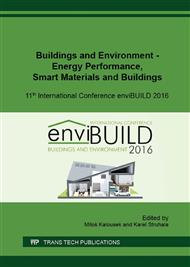p.303
p.311
p.320
p.327
p.335
p.343
p.353
p.361
p.369
Calibration Method of Cool Box Used for Measuring of Thermal Conductivity Coefficient
Abstract:
One of the methods used for determining of the thermal conductivity coefficient value of building materials is the Calibrated and Guarded Hot Box method. This method is based on the principle of measuring the heat flux density that passes through the test specimen at a temperature difference between warm and cool parts of the measuring box. For measuring of thermal conductivity coefficient is at the Faculty of Civil Engineering of VŠB-TUO used the Cool Box. Measuring in Cool Box uses the same principle of measuring as Calibrated and Guarded Hot Box. For creating temperature difference during the measurements at the Cool Box is not used heat, but cold. Measurement of the thermal conductivity coefficient by a Cool Box is very complex in terms of measurement accuracy. That the resulting values as accurate as possible, it is necessary to calibrate itself refrigerated cabinets and all sensors that are used for measurements. This paper describes the principles of calibration of Cool Box and other components, which are used for measuring the thermal conductivity coefficient of selected natural building materials. Determination of the thermal insulation properties of selected materials is part of a long-term research focused on conventional and unconventional natural building materials.
Info:
Periodical:
Pages:
335-342
Citation:
Online since:
December 2016
Authors:
Price:
Сopyright:
© 2017 Trans Tech Publications Ltd. All Rights Reserved
Share:
Citation:


